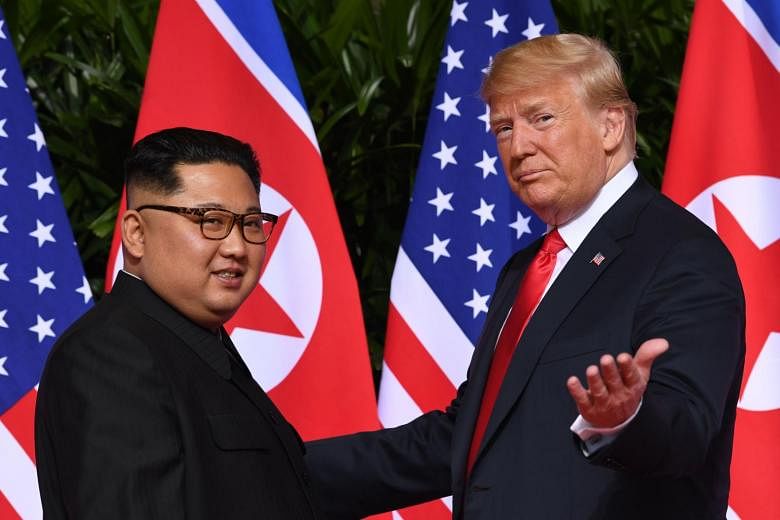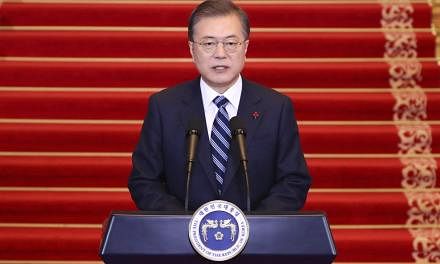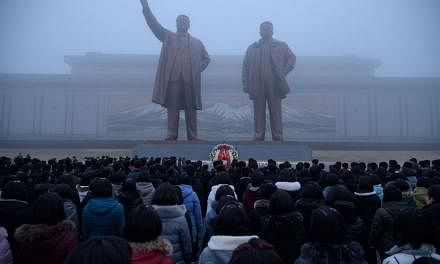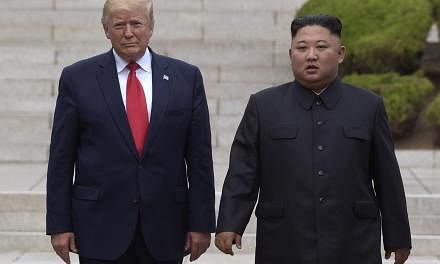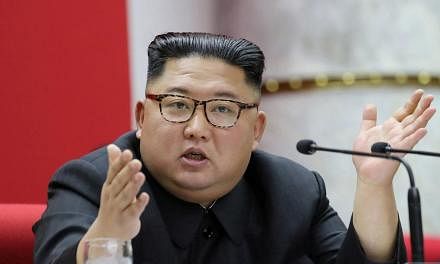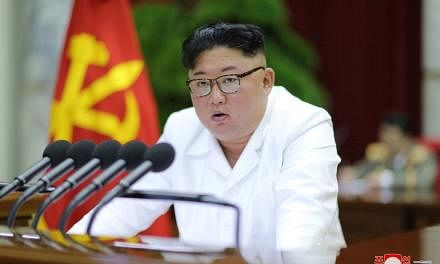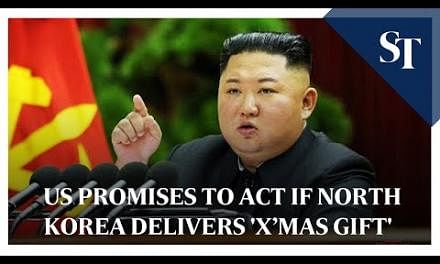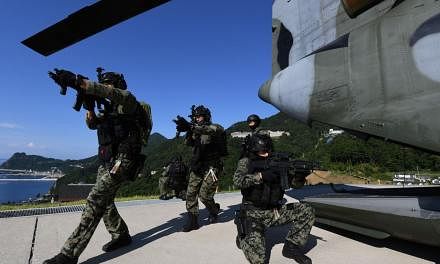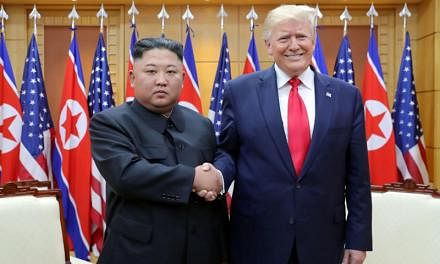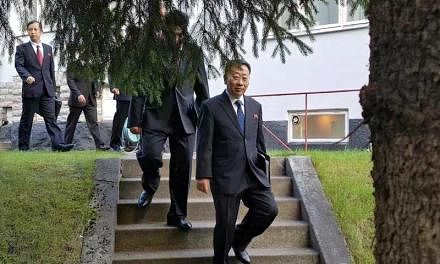TOKYO (BLOOMBERG) - Three meetings between the leaders of the United States and North Korea resulted in no concrete plans to end Pyongyang's atomic ambitions.
US President Donald Trump and North Korean leader Kim Jong Un have toned down hostile rhetoric since they first shook hands in Singapore in June 2018. They were cordial even after their second summit broke down in Hanoi in February, and then took a historic stroll together into North Korea four months later.
All the while, Pyongyang's nuclear programme quietly advanced as US-backed sanctions choked its moribund economy.
The two countries cannot agree on what the denuclearisation of North Korea means and what rewards should be given, if any, in response to Pyongyang's moves towards disarmament.
But Mr Trump has invited Mr Kim to the White House, while a top aide to Mr Kim has touted the "mysteriously wonderful" chemistry between the two leaders.
1. WHAT HAVE THEY AGREED TO?
The first summit resulted in a bare-bones declaration that contained four main items: To normalise ties between the US and North Korea, formally end the 1950-53 Korean War, repatriate US war remains, and "to work towards complete denuclearisation of the Korean peninsula".
But "work towards" is undefined. It is also unclear whether the US nuclear umbrella over South Korea is included.
US Secretary of State Mike Pompeo says that Mr Kim accepted the "final, fully verified denuclearisation of North Korea".
North Korea points out that the agreement referred to the entire peninsula and insists that US weapons must go at the same time, or it would be left vulnerable to attack.
A meeting between Mr Kim and Mr Trump within the Demilitarised Zone in June this year led to an agreement to resume working-level talks to work on details. After three months, a date was finally set: Oct 5, with a "preliminary contact" the day before.
2. WHAT DOES THE US WANT?
To start, the US wants North Korea to provide an inventory of weapons, facilities and fissile material it has produced. Mr Kim's regime calls that akin to asking for a "target list".
Further steps would include inspections, closing facilities and destroying weapons, and even surrendering nuclear material, according to proliferation experts. Past talks have faltered on the question of inspections and verification.
3. WHAT DOES NORTH KOREA WANT?
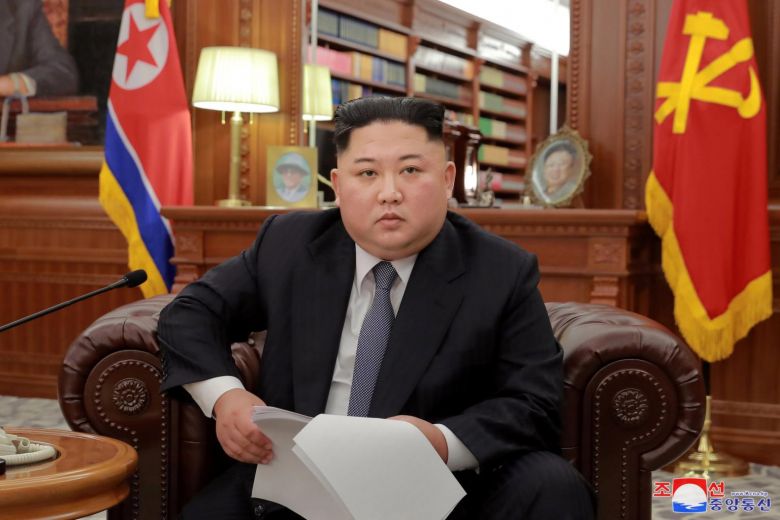
Mr Kim wants "corresponding measures", or immediate rewards, for any steps his regime makes. In a televised New Year's address, Mr Kim threatened to take a "new path" if Washington did not relax crippling economic sanctions.
He signalled that any deal might require weakening the US-South Korean alliance, urging Seoul not to resume military exercises with the American side. And he made clear that he believed the denuclearisation pledge includes "strategic assets" such as America's nuclear-capable planes and warships. But his language was less bellicose than past years', possibly reflecting his limited options.
4. WHAT HAS NORTH KOREA OFFERED?
In Hanoi, North Korea offered to shut down parts of its Yongbyon nuclear complex, which has served as the crown jewel of its atomic programme, in return for sanctions relief.
The ageing facility about 100km north of Pyongyang was once the main source of its fissile material, turning out roughly enough plutonium each year for one atomic bomb. But North Korea has since turned to uranium enrichment for weapons.
Still, Yongbyon remains its main atomic research facility and a complete closure would affect its nuclear programme.
5. HOW DID THE HANOI SUMMIT END?
Abruptly. Mr Trump said he walked out after Mr Kim insisted that sanctions be completely lifted.
North Korea's Foreign Minister Ri Yong Ho disputed Mr Trump's claim, saying that North Korea only asked that United Nations sanctions imposed in 2016 and 2017 be lifted. He also said that Mr Kim had pledged not to restart missile testing.
The two sides, which do not have diplomatic relations, have also floated a deal to end the 1950-53 Korean War which had been halted by a truce, and talked about setting up liaison offices in the other's capital.
6. HAS THERE BEEN ANY PROGRESS?
Small steps. In July 2018, North Korea released some 55 sets of remains of US troops killed in the Korean War, but negotiations slowed over the remains of thousands of others.
While Mr Kim followed through on pledges to refrain from nuclear weapons tests and dismantle testing facilities, those were moves he had committed to before meeting Mr Trump, having declared the testing phase complete.
On the US side, Mr Trump suspended or scaled back military drills with South Korea, calling them expensive "war games". In doing so, he overruled then-defence secretary Jim Mattis. But the Trump administration also imposed extra sanctions on some North Koreans.
Relations between North and South Korea improved somewhat, with a deal in September 2018 for removing land mines and some guard posts from the border zone. But Mr Trump rejected as premature a proposal from South Korean President Moon Jae-in for confidence-building economic projects with North Korea.
In June 2019, Mr Trump praised a "beautiful" letter from Mr Kim and asked via Twitter for a meeting when he would be in South Korea.
Mr Trump and Mr Kim met in the DMZ and shook hands at the border. Mr Trump then joined Mr Kim in a brief walk north across the line to become the first sitting US president to set foot in North Korean territory.
7. WHERE DOES CHINA STAND?
The US-China trade war has complicated cooperation between Washington and Beijing, but China has said it backs further meetings between Mr Trump and Mr Kim. The problem for Mr Trump is that China - as North Korea's dominant trading partner and sole security ally - is key to maintaining the economic isolation on which the US is relying to force Mr Kim back to the negotiating table.
While China has repeatedly affirmed its commitment to international sanctions, the country has shown its limits; for instance, China joined Russia in blocking the UN Security Council committee that monitors sanctions from declaring that North Korea exceeded its annual import cap on refined petroleum products, the Associated Press reported in June.
President Xi Jinping made the first visit by a Chinese leader to North Korea in 14 years in June, saying he wished to "open a new chapter" in ties.
8. IS NORTH KOREA STILL DANGEROUS?
Mr Trump declared after the first summit that North Korea was "no longer a nuclear threat". The prospect of war seems to have receded, but since the first meeting, North Korea likely produced enough fissile material for four or more atomic bombs and worked on making more missiles that could deliver a warhead to anywhere on the US mainland.
Satellite images released in March showed that North Korea was rebuilding a long-range rocket site it recently dismantled.
In May, Mr Kim started a series of military tests that has led to his state firing off about 20 ballistic missiles, including a test on Oct 2 of what is thought to be a submarine-based rocket. The tests have stopped just short of challenging Mr Trump's bottom line by continuing a moratorium on intercontinental ballistic missile firings and underground nuclear tests.
Mr Trump referred to the missiles tested as "some small weapons", saying the operation "disturbed some of my people, and others, but not me".
9. WHY ISN'T THE KOREAN WAR OFFICIALLY OVER?
Because the parties involved in talks to end the war - China, North Korea and the US-led UN Command - never were able to agree on a peace treaty. What was signed in 1953 was only an armistice, or truce.
However, signing a treaty now without a disarmament deal carries risks for the US, because it could legitimise Mr Kim's control over half of the peninsula and undermine the rationale for stationing 28,000 or so American troops in South Korea. Each side uses the continued threat of attack to justify its own military activities.
